How Do I Hang My Hammock?
-
Table of Contents
- Introduction
- Cord-Based Systems
- Webbing-Based Systems
- Advanced Hanging Techniques
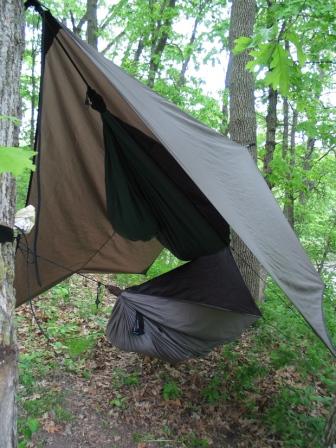
Hanging Two Hammocks
Pic by FreeTheWeasel
Just Jeff's Outdoors Page"Going to the woods is going home, for I suppose we came from the woods originally." ~John Muir |
|
|

Hanging Two Hammocks
Pic by FreeTheWeasel
| 1. Introduction. |
The purpose of hammock suspension is to support the hammock safely without damaging the environment. Everything else - low weight, bulk, complexity and expense - are secondary concerns.
Now let's break this apart:
Materials are another consideration. Suspension is usually made from low-memory stretch cord like Spectra or polyester or polypropylene webbing. Low-memory stretch means that, once the material is stretched out from you laying in it, it doesn't remember how to pull back to its original position...it stays stretched out so your hammock doesn't end up on the ground every morning. High-memory stretch material like nylon pulls back to its original position...so you'll end up hanging much lower every morning than you started the previous night. Paracord (550 cord) is made from nylon so it can stretch to absorb opening shock...in addition to not being strong enough, it stretches too much to be an effective hammock support. Slap Straps by Eagles Nest Outfitters are currently made from nylon...many hammockers have tried and discarded this approach because of this. If you like the system, make your own from polyester or polypro webbing.
Two Key Decisions. There are two key decisions to make for your suspension.
Each of these will be discussed in the following sections.
| 2. Cord-Based Systems. |
Cord-based systems use rope or cord to connect the hammock to the tree. As discussed above, some method must be used to ensure the system does not damage the tree. This is usually tree huggers like the ones included Hennessy Hammocks products. Tree huggers are simply 1-1.5" wide lengths of webbing with loops at each end. The length needed depends on how big the trees are where you hike. You can get longer tree huggers as an option on the Hennessy website, from Strapworks, or make your own.
I needed longer huggers so I made the ones on the right. I used 1" nylon webbing for a finished length of 52". The stock Hennessy tree huggers (Backpacker model) are on the left for comparison. Ignore the no-tail cat.
Nylon is ok to use for huggers because there isn't much room to stretch (compared to the full length of the support).
Sometimes I'll take one long hugger and one short hugger so I'm more prepared for bigger trees. Other times, I'll just bring an extra hugger so I can combine it with whichever end needs more length. Instructions for that here.
| 2.1. Connecting Cordage to Hammock |
See pictures of the Hennessy whipping being deconstructed here. |
| 2.2. Connecting Cordage to Tree |
The major benefit to this method is weight and simplicity - it's probably the lightest method and it doesn't require any hardware to break or malfunction. The downsides are that it's a bit of a hassle to learn, to make a small adjustment you have to redo the entire lashing, and since the tree huggers are separate they can be forgotten on the tree. |
Using carabiners quickens setup, but it can also keep the entire setup in one piece so you don't forget the tree huggers when you break camp. |
| Detail - Combining Tree Huggers |
First, set the two huggers side by side. Here, the Hennessy is the black one on the left and my homemade one is the dark green one on the right. |
These pull pretty tight when you put weight on them so it can be a bit of a hassle to get them apart, but it's not too bad. |
| 2.3. Garda Hitch with Ring Buckles |
There are several ways to add rings to a hammock to use the Garda Hitch. I have pics of a few of the methods below...have a look and hopefully you'll find it useful in creating your own system. FYI - there are several Garda Hitch threads on Hammock Forums...here's one.
Here's a very easy way that I use for my DIY hammocks.
You can also put the ring buckles at the tip of the suspension triangle if you want to modify your BMBH or make your own DIY bridge. See the Grizzly Adams pictures in the webbing section for more details on this. |
| 3. Webbing-Based Systems. |
Webbing systems can be the simplest suspension to make if you connect directly to the hammock and use the 4-Wrap lashing. Adding in some hardware - like ring buckles, cinch buckles, tri-glides - can make it much more convenient to use, and it is still simple because there are no tree huggers to worry about. Webbing does tend to weigh more and be bulkier than comparable cord-based systems.
Some random notes:
| 3.1. Connecting Webbing to Hammock |
 As I said above, I think the larkshead or girth hitch is one of the simplest methods of attaching webbing or cord to a hammock. For webbing, I have a sewn loop in one end and I just run the free end thru the loop to create the girth hitch that cinches down on the hammock. The weighted hammock keeps the hitch tight. As I said above, I think the larkshead or girth hitch is one of the simplest methods of attaching webbing or cord to a hammock. For webbing, I have a sewn loop in one end and I just run the free end thru the loop to create the girth hitch that cinches down on the hammock. The weighted hammock keeps the hitch tight. |
| 3.2. Connecting Webbing to Tree | |
Running Thru Sewn Loop |
Biner on Sewn Loop |
The major advantage to this setup is that there are no moving parts to malfunction...it's very simple. The downsides to this method are that it isn't as easy to adjust as the others and a lot of webbing means more weight than a simple cord/hugger system (but still comparable to hardware-based systems). |
|
| 3.3. Ring Buckles on Webbing |
|
The concept behind ring buckles is simple - connect two rings together using a larkshead, and run the hammock support thru the rings just like an old fashioned belt or a motorcycle helmet. With strong enough webbing, the rings should create enough friction to hold a hammocker securely. I use 1" polypro webbing from Speer Hammocks and 4 x SMC Descending Rings with 1.5" internal diameter. SMC rings are available from many climbing shops, including REI. I connect the rings to the hammock with Air Core Plus from backpackinglight.com. See my step-by-step instructions if you want to make your own.
|
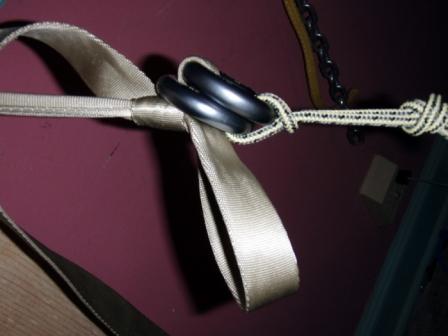 Some people say the webbing slips thru the ring buckles, and usually lowers them slowly to the ground. Putting a simple half-hitch in the webbing right behind the rings stops the webbing from slipping. This takes about 2 seconds and the system is still very easy to adjust...just pull the free end and the half-hitch slips right out for you to make the adjustment. Some people say the webbing slips thru the ring buckles, and usually lowers them slowly to the ground. Putting a simple half-hitch in the webbing right behind the rings stops the webbing from slipping. This takes about 2 seconds and the system is still very easy to adjust...just pull the free end and the half-hitch slips right out for you to make the adjustment.I've only had the webbing slip when it wasn't lined up correctly. If I take care to keep the webbing lined up thru the rings it's always held me steady. (Photo by slowhike) |
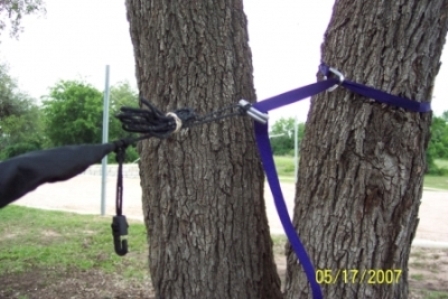 Some people want to try the ring buckles before they permanently modify their hammock by cutting off the spectra. This picture shows how Miu attached ring buckles to her Hennessy to test out the buckles. Some people want to try the ring buckles before they permanently modify their hammock by cutting off the spectra. This picture shows how Miu attached ring buckles to her Hennessy to test out the buckles.Photo by Miu |
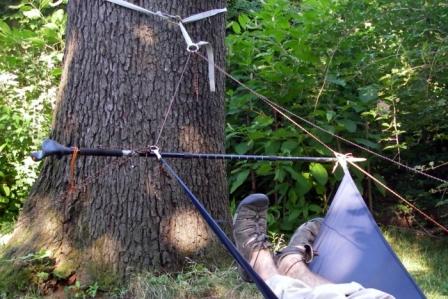 If you like this system, you can permanently modify your bridge hammock by putting the descending rings at the tip of the bridge's suspension triangle. This picture shows Grizzly Adams' DIY bridge with ring buckles. He's using webbing but the Garda Hitch will work just as well in this mode if you want to use cord. (Photo by Grizzly Adams) If you like this system, you can permanently modify your bridge hammock by putting the descending rings at the tip of the bridge's suspension triangle. This picture shows Grizzly Adams' DIY bridge with ring buckles. He's using webbing but the Garda Hitch will work just as well in this mode if you want to use cord. (Photo by Grizzly Adams) |
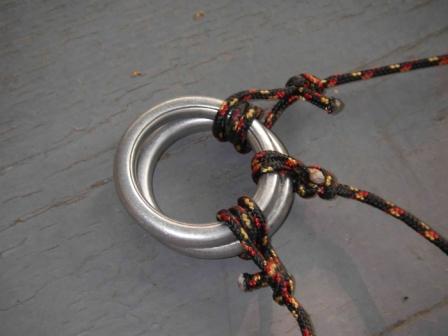 Here's a close-up of the ring buckles on Grizz's bridge. The outer two pieces of cord are from the suspension triangle, and the middle one is for the ridgeline. (Photo by Grizzy Adams) Here's a close-up of the ring buckles on Grizz's bridge. The outer two pieces of cord are from the suspension triangle, and the middle one is for the ridgeline. (Photo by Grizzy Adams) |
| 3.4. Cinch Buckles on Webbing |
| Cinch buckles are another way to quickly adjust webbing suspension. Crazy Creek uses these buckles on their webbing, but I didn't like how their webbing system worked so I got some more buckles and made my own using a webbing adaptor. Blackbishop made some without a webbing adaptor and I like these better, if the cord is stiff enough to keep the buckle aligned.
Lots of hammockers prefer cinch buckles over ring buckles, even though they weigh a little more, because they never slip, the webbing doesn't misalign, and you don't need a half-hitch to back it up. Although I've never slipped with the ring buckles when the webbing was aligned, the cinch buckles seem a little more foolproof.
|
 Here's a closeup of the cinch buckle showing how the extra wraps keep the buckle aligned by not giving any room for the buckle to slip sideways. Here's a closeup of the cinch buckle showing how the extra wraps keep the buckle aligned by not giving any room for the buckle to slip sideways.Buy these buckles from Amazon: Cinch 1". Photo by angrysparrow |
| 3.5. Tri-Glides on Webbing |
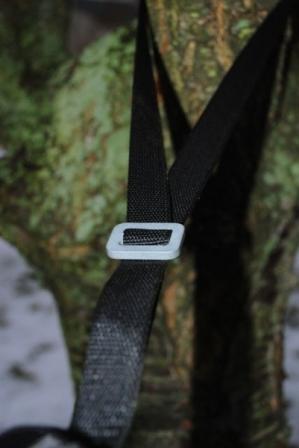 Tri-Glides are a JacksRBetter product that allows use of 1" webbing without having to remove any pieces or adding the weight of rings or buckles. The webbing still has to be threaded thru the tri-glides for each setup so it isn't quite as quick as rings or cinch buckles, but at only 22 grams a set this is an excellent combination of simplicity, adjustability and weight. Tri-Glides are a JacksRBetter product that allows use of 1" webbing without having to remove any pieces or adding the weight of rings or buckles. The webbing still has to be threaded thru the tri-glides for each setup so it isn't quite as quick as rings or cinch buckles, but at only 22 grams a set this is an excellent combination of simplicity, adjustability and weight.Photo by cgul |
| Do You Need Webbing? |
| 4. Advanced Hanging Techniques. |
| 4.1. Two Hammocks Under One Tarp |
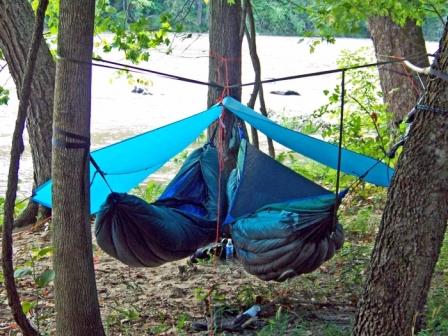
While the photo by Seuss to the left has the hammock tied to two different trees, I usually wrap my hammock off of one side of the tree and my son's hammock off the other side of the same tree. It's enough separation for us to be comfortable and I'm close enough to check on him during the night...make sure he's on his insulation, not sweating, etc. This picture is Joker (poking his head out of the Hammock Sock) and me at the 2007 Mt Rogers Hangout under a MacCat Standard tarp.
 FreeTheWeasel demonstrates how to hang two hammocks vertically on the same tree. If the tarp is big enough to provide coverage and you can get in, do what works! FreeTheWeasel demonstrates how to hang two hammocks vertically on the same tree. If the tarp is big enough to provide coverage and you can get in, do what works!Photo by FreeTheWeasel |
| 4.2. Hanging in Trail Shelters |
| Hanging in shelters can be just as convenient for a hammocker as for a ground dweller, but it's important to remember the forces the supports can exert on the shelter's walls. If the shelter looks rickety, don't hang. And if it looks like it can support you, pick your supports carefully and listen for creaks. |
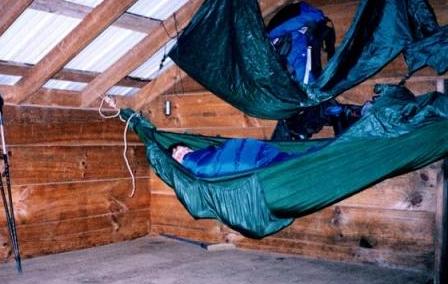 Clark Hammock in an AT Shelter photo by Hikerhead. Clark Hammock in an AT Shelter photo by Hikerhead.You should also be aware of what other hikers think about it...it's a pretty controversial topic on WhiteBlaze.net. The big thing is that you're not only putting your own safety at risk...if the shelter fails you hurt them as well, and the maintenance crew has to come build a new one, etc. |
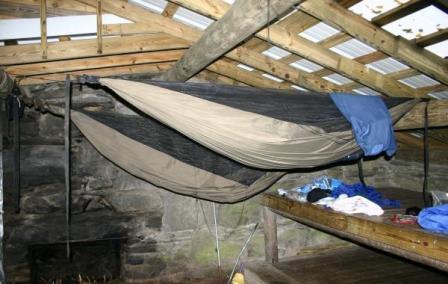 HHs in Tri-Corner Knob Shelter, GSMNP photo by Repeat. One advantage to others when you hang in a shelter, though, is that you're not taking up the floor space. No one may want to hang below you, but at least they can put a pack under you and you're not breathing in each others' faces. |
| 4.3. Hanging with Rock Climbing Gear. |
 Photo by nigelp Photo by nigelpSome locations don't have many trees to hang from, so rock climbing nuts and cams can open up a whole new set of possible hanging sites. In this picture NigelP hangs with rock climbing gear. Check this HF thread for more discussion. |
 Photo from nigelp. Another view of his setup. Photo from nigelp. Another view of his setup. |
Top of Page | Site Map | Privacy Policy
© 2005 to Present | Email Me